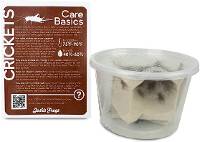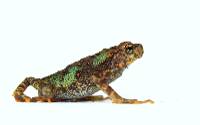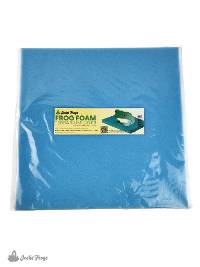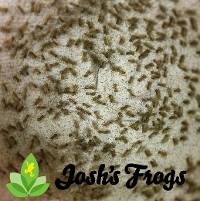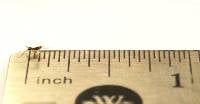Josh's Frogs
Why you should buy from us
Female Yellow-Spotted Climbing Toad - Rentapia flavomaculata (Captive Bred)
Female Yellow-Spotted Climbing Toad - Rentapia flavomaculata (Captive Bred)
$249.99 0.0 out of 5 stars
(0)
0.0 out of 5 stars
(0)About This Product
Check out our Yellow-Spotted Climbing Toad podcast and more on our YouTube channel!
Defining Characteristics:
- Great beginner toad
- Largest arboreal toad species
- Bold
- Easy to Keep
- Loud Honking Call
- Large
- Can be kept in groups
- Challenging to Breed
Name: Yellow-Spotted Climbing toads go by the scientific name Rentapia flavomaculata, formerly Pedostibes hosii. It is typically called the Yellow-Spotted Climbing Toad, sometimes shortened to YSCT in internet shorthand, and is also known as the Common Tree Toad or the Asian Yellow-Spotted Climbing Toad. This toad is in the family Bufonidae, and is considered a true toad. This species has been separated out from Rentapia hosii as of 2020. R. hosii is found only on the island of Borneo and the females are visibly different from flavomaculata.
Recommended Vivarium Size & Setup: Housing Rentapia flavomaculata is can be very simple. These anurans require a lot of space, but they do not need a very complex habitat. Something the size of an 18x18x24 glass terrarium can house 1-2 adults, while a 29 gallon could house about the same amount of toads. Ventilation is a must, as these toads will not tolerate stagnant moist air for very long. A screen top will help provide this.
Substrate recommendations vary considerably, but ground coconut fiber works well for Josh’s Frogs. Provide plenty of décor that your Rentapia flavomaculata can climb on, such as manzanita wood, cork bark tubes, artificial vines, or artificial plants.
A shallow water bowl should be provided, as well. Yellow-Spotted Climbing Toads do benefit from UVB lighting such as a 5.0 or UVB100 UVB bulb. If you'd like to keep housing yellow-spotted climbing toads simple, check out the Josh's Frogs Yellow-Spotted Climbing Toad Complete Care Kit.
Temperature (°F): They can tolerate temperatures from 65 to over 85°F, but ideally are kept at about room temperature, from the mid to high 70s. A low wattage basking spot may be utilized, especially by gravid females.
Humidity: In the wild, precipitation and humidity fluctuates based on season, with a heavy rainy season in the early part of the year. Yellow-spotted climbing toads can handle a wide range of humidity levels, but prefer humidity levels around 50-70% with plenty of ventilation/air movement. Moist, stagnant air is a big no-no when keeping older Rentapia flavomaculata, while very young animals dry out easily. Routine spraying and a full screen top will aid in providing proper humidity levels. Yellow-Spotted Climbing Toads handle short periods of low humidity much better than most tree frogs.
Size: Adult yellow-spotted climbing toads are fairly large, and there is a drastic size different between males and females. An adult male may reach about 4 inches, but most will be closer to 3 - 3.5 inches. We have one large wild caught male that measures almost 5 inches! A large female will be much larger and bulkier than a male, and may measure up to 5.5 inches. These are sexed female toads that were born in March of the previous year, and are over 2 inches in length.
Age: There is not any good data surrounding the average lifespan of yellow-spotted climbing toads, but wild caught animals have lived in captivity for 5 or more years. These sexed animals were born in March of last year.
Feeding: It is reported that YSCTs come down to the forest floor at night to pursue prey, and that is certainly in line with what we've observed at Josh's Frogs. Yellow-Spotted Climbing Toads can eat rather large food, and easily consume adult crickets as adults.
At Josh’s Frogs, we feed our adult yellow-spotted climbing toads primarily adult crickets, as well as dubia roaches, and the occasional superworm, waxworm, or hornworm. Young yellow-spotted climbing toads start life feeding on pinhead crickets. At the size Josh’s Frogs sells captive bred yellow-spotted climbing toads, they are eating 1/2 inch crickets. All prey items should be dusted with a quality vitamin/mineral supplement.
Sexing: Sexing adult Yellow-Spotted Climbing Toads is quite easy. Once the toads are about 10-12 months old, they display obvious sexual dimorphism. Females are about 1.5-2 times larger then males, and much more rotund. Males are smaller, more slender, and typically call when kept in a wet or more humid environment. Color between the sexes varies widely - please read the Color/Pattern section below.
A male yellow-spotted climbing toad's call is very loud and hard to miss! CLICK HERE to hear it!
Color/Pattern: They can be a very variable species, at least when it comes to females. Offspring start off dark brown with yellow bands on the legs. Males change colors as they mature, and generally appear as a solid gray/brown animal, with very, very faint yellowish bands on their legs. Females are much more brightly colored, especially during the breeding season. Females may have a base coloration of green to teal to blue, with yellow band on their legs and spots over the rest of their body.
Social Behavior: Yellow-Spotted Climbing Toads are not outwardly aggressive towards each other, and do great housed in groups. Josh's Frogs recommends housing adult females and males separate from each other outside of the breeding season, to avoid stress. Males may dominate each other by mounting/climbing over their cage mates (as shown above)—this generally is only a momentary inconvenience, and seldom results in any long term harm.
Breeding: Captive breeding of these toads is few and far between, with most recorded breeding resulting in only a couple dozen toadlets. The earliest captive breeding we could find was reported in 1994. From what we've been able to dig up, it appears Rentapia flavomaculata has only been bred a handful of times in the United States, and even less frequently overseas. We believe the primary reason for this is the horrible shape most wild caught animals arrive in when they reach the US—even with veterinary care, most will not make it. With wider availability of healthy, captive bred yellow-spotted climbing toads, Josh's Frogs hopes captive breeding will be a more frequent occurrence, and negate the need for wild toads to be imported for the pet trade.
Beginning in November or December, reduce the mistings and feedings of the toads down to about half of normal. Maintain this for a couple months, gradually increasing the humidity and feedings in early January. Females tend to develop eggs in the late winter/early spring, and become visibly gravid in late February or early March, which is towards the end of the rainy system in Malaysia. Once females appear gravid and begin to actively escape their enclosure to get to calling males (males tend to call year round, and should be housed separately from females to avoid unneeded stress during the off season), add a female and 2-3 males in a basic rain chamber with at least 4-5 inches of water at the bottom, and wait! Within a few days, thousands of small eggs, laid in 2 parallel strings, are laid underwater wrapped around plants.
Please read the Josh's Frogs Yellow-Spotted Climbing Toad Breeding Journal for more information.
Natural Range: Yellow-spotted climbing toads hail from subtropical and tropical lowland rainforests in Thailand, Malaysia, Borneo, and Sumatra, with most animals in captivity hailing from Malaysia. Rentapia flavomaculata is the only true arboreal species of toad, and populations tend to be concentrated in primary forest near streams, in which they breed. Young initially live at the ground level, then move up into the trees as they grow. Unfortunately, the Yellow-Spotted Climbing Toad cannot adapt to altered forest, and requires a pristine environment to survive. It's population level is decreasing, although it is currently considered a species of least concern.
History in the Hobby: Imported infrequently from Malaysia, Yellow-Spotted Climbing Toads have been in the US hobby since at least the 1990s. In the past, males were very difficult to acquire due to the more colorful females being collected, and the brown and rather dull colored males thought to be less desirable by importers. In the past several years, many more males have been imported than females.
Bred very infrequently in captivity, Josh's Frogs acquired a wild caught 2.1 group (actually 3.0, with a very large old male!) in 2011, then a wild caught 4.2 group in 2013 a hobbyist had successfully bred in small numbers earlier that year. We are working to breed a second female and create an additional line to contribute to genetic diversity. Due to recent changes in Malaysia's import/export laws, it is unlikely that Rentapia flavomaculata will be exported in the future, at least in large amounts.
A Special Note on Shedding: All frogs and toads shed, but they don't always do it in public! Yellow-Spotted Climbing Toads are not shy about it whatsoever, and will typically shed at least once a week. They'll develop a shiny appearance for a few hours, before using their legs to peel off the old skin, then eat it. During this time, the toad will generally hang out at the bottom of the tank. Do not be alarmed—this is completely normal behavior, even though it looks a little strange!
Links of Interest:
- AmphibiaWeb article on YSCTs.
- Wikipedia article on Yellow-Spotted Climbing Toads. Not much info, but a cool picture!
- IUCN redlist article on Pedostibes hosii, focusing on their status in the wild and current threats.
- Dendroboard.com forum post on breeding of YSCTs.
- Encyclopedia of Life articles and information on Yellow-Spotted Climbing Toads - sweet pic!
Still not sure if Rentapia flavomaculata from Josh's Frogs are the right pet frog for you? Read the reviews below and see what other customers are saying! Then, make sure to check out our more in depth Yellow-Spotted Climbing Toad Care Sheet!
Shipping
After placing an order containing a live animal, you will receive a scheduling email containing our JotForm scheduling link to schedule your new pet's delivery date.
With this scheduling link, you will be able to schedule your order's delivery up to 30 days in advance. You will be able to choose a date of delivery for Tuesday-Saturday (Saturday arrival depends on the carrier's service availability) with the estimated time of arrival generally being 12pm, or 4:30pm for more rural areas. Overnight lows must be above 40°F to ship directly to you (or above 30°F for FedEx Ship Center pickups) as well as below 90°F by estimated time of arrival.
If you require further assistance, or prefer to talk to one of our Customer Service agents, please feel free to reach out to our [email protected] email or our phone line 1-800-691-8178.
Other Customers Also Bought
Customer Reviews
0.0 out of 5 stars
Review data
5 star reviews
- 0%
4 star reviews
- 0%
3 star reviews
- 0%
2 star reviews
- 0%
1 star reviews
- 0%


